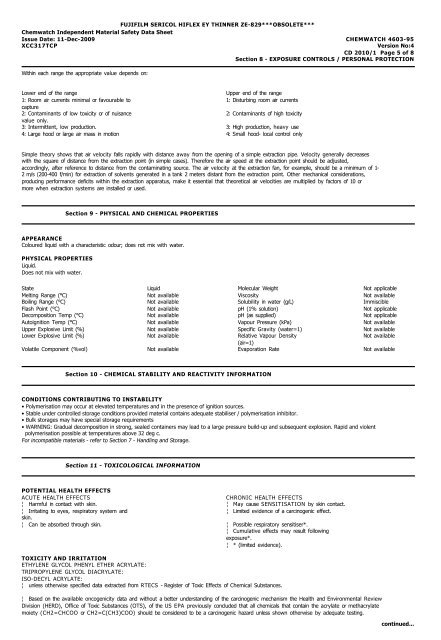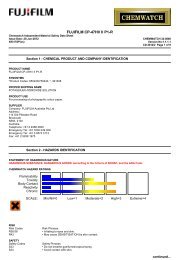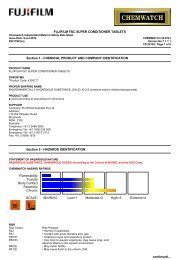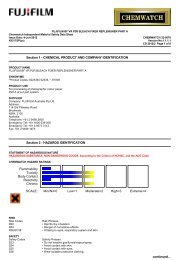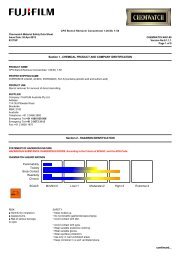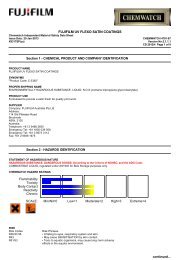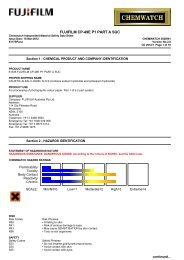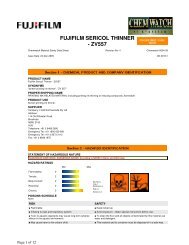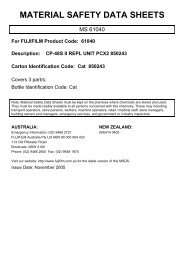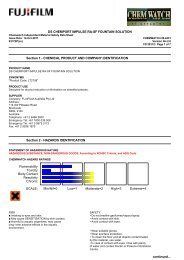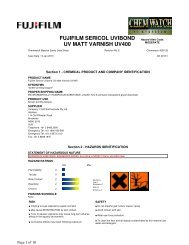Chemwatch MSDS Print - FUJIFILM Australia
Chemwatch MSDS Print - FUJIFILM Australia
Chemwatch MSDS Print - FUJIFILM Australia
Create successful ePaper yourself
Turn your PDF publications into a flip-book with our unique Google optimized e-Paper software.
<strong>FUJIFILM</strong> SERICOL HIFLEX EY THINNER ZE-829***OBSOLETE***<strong>Chemwatch</strong> Independent Material Safety Data SheetIssue Date: 11-Dec-2009 CHEMWATCH 4603-95XCC317TCPVersion No:4CD 2010/1 Page 5 of 8Section 8 - EXPOSURE CONTROLS / PERSONAL PROTECTIONWithin each range the appropriate value depends on:Lower end of the rangeUpper end of the range1: Room air currents minimal or favourable to 1: Disturbing room air currentscapture2: Contaminants of low toxicity or of nuisance 2: Contaminants of high toxicityvalue only.3: Intermittent, low production. 3: High production, heavy use4: Large hood or large air mass in motion 4: Small hood- local control onlySimple theory shows that air velocity falls rapidly with distance away from the opening of a simple extraction pipe. Velocity generally decreaseswith the square of distance from the extraction point (in simple cases). Therefore the air speed at the extraction point should be adjusted,accordingly, after reference to distance from the contaminating source. The air velocity at the extraction fan, for example, should be a minimum of 1-2 m/s (200-400 f/min) for extraction of solvents generated in a tank 2 meters distant from the extraction point. Other mechanical considerations,producing performance deficits within the extraction apparatus, make it essential that theoretical air velocities are multiplied by factors of 10 ormore when extraction systems are installed or used.Section 9 - PHYSICAL AND CHEMICAL PROPERTIESAPPEARANCEColoured liquid with a characteristic odour; does not mix with water.PHYSICAL PROPERTIESLiquid.Does not mix with water.State Liquid Molecular Weight Not applicableMelting Range (°C) Not available Viscosity Not availableBoiling Range (°C) Not available Solubility in water (g/L) ImmiscibleFlash Point (°C) Not available pH (1% solution) Not applicableDecomposition Temp (°C) Not available pH (as supplied) Not applicableAutoignition Temp (°C) Not available Vapour Pressure (kPa) Not availableUpper Explosive Limit (%) Not available Specific Gravity (water=1) Not availableLower Explosive Limit (%) Not available Relative Vapour Density Not available(air=1)Volatile Component (%vol) Not available Evaporation Rate Not availableSection 10 - CHEMICAL STABILITY AND REACTIVITY INFORMATIONCONDITIONS CONTRIBUTING TO INSTABILITY• Polymerisation may occur at elevated temperatures and in the presence of ignition sources.• Stable under controlled storage conditions provided material contains adequate stabiliser / polymerisation inhibitor.• Bulk storages may have special storage requirements• WARNING: Gradual decomposition in strong, sealed containers may lead to a large pressure build-up and subsequent explosion. Rapid and violentpolymerisation possible at temperatures above 32 deg c.For incompatible materials - refer to Section 7 - Handling and Storage.Section 11 - TOXICOLOGICAL INFORMATIONPOTENTIAL HEALTH EFFECTSACUTE HEALTH EFFECTSCHRONIC HEALTH EFFECTS¦ Harmful in contact with skin. ¦ May cause SENSITISATION by skin contact.¦ Irritating to eyes, respiratory system and ¦ Limited evidence of a carcinogenic effect.skin.¦ Can be absorbed through skin. ¦ Possible respiratory sensitiser*.¦ Cumulative effects may result followingexposure*.¦ * (limited evidence).TOXICITY AND IRRITATIONETHYLENE GLYCOL PHENYL ETHER ACRYLATE:TRIPROPYLENE GLYCOL DIACRYLATE:ISO-DECYL ACRYLATE:¦ unless otherwise specified data extracted from RTECS - Register of Toxic Effects of Chemical Substances.¦ Based on the available oncogenicity data and without a better understanding of the carcinogenic mechanism the Health and Environmental ReviewDivision (HERD), Office of Toxic Substances (OTS), of the US EPA previously concluded that all chemicals that contain the acrylate or methacrylatemoiety (CH2=CHCOO or CH2=C(CH3)COO) should be considered to be a carcinogenic hazard unless shown otherwise by adequate testing.continued...


